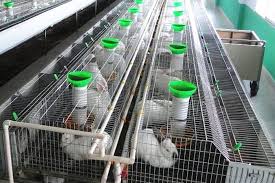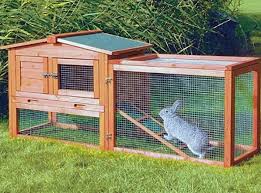Rabbit housing (hutches and cages) and equipment vary from country to country. Factors influencing their design include climate, availability and cost of raw materials, scale and system of production, and the expertise of the rabbit keeper.
However, there are some basic requirements all hutches and equipment should meet. Any new or existing hutches and equipment should be assessed against these standards.
Read Also: Sheep gene insights could help farmers breed healthier animals
A. Housing Requirements for Rabbits

A rabbit hutch must provide adequate space and protection for the rabbit, as well as convenience for the rabbit keeper.
1. Space: Since rabbits will spend their lives in the hutch, it is important to provide enough space to minimize restrictions on movement. To allow rabbits to stretch and perform normal activities, both horizontal and vertical space are essential. Sufficient space also aids in good ventilation and temperature regulation within the hutch, which are crucial for maintaining health and preventing diseases.
2. Protection: To ensure the farmer’s success, it is necessary to offer adequate protection for the rabbits. This protection must guard against injuries within the hutch, direct sunlight, rain, wind (both direct and indirect), sudden noises, predators such as dogs, cats, rats, snakes, safari ants, and even human thieves.
3. Convenience for the Rabbit Keeper: For a successful farm operation, the housing should be designed to assist the keeper in performing routine tasks such as observation, examination, handling, feeding, mating, cleaning, and disinfecting. Additionally, the design should allow room for expansion as the rabbit population grows.
B. Types of Rabbit Housing
There are two primary types of housing:
1. Indoor Hutches: Indoor hutches can be simpler than outdoor hutches, often constructed using simple boxes made of wired frames. These can be hung in various ways. Indoor hutches are suitable for established rabbit keepers who have a stable market to justify the setup costs. They provide favorable conditions for both rabbits and their keepers, making observation and cleanliness easier. They also protect rabbits from predators. However, the initial investment required makes them less feasible for beginners.
2. Outdoor Rabbit Hutches: Outdoor hutches are relatively inexpensive to set up and are ideal when starting production. However, they cannot always provide adequate protection during storms or extreme weather conditions. Additionally, outdoor hutches are often difficult to clean and maintain dry, and expanding the number of hutches quickly can be challenging.
C. Floor Methods of Housing for Rabbits
This method involves keeping rabbits on the ground within a fenced area, providing simple boxes for shelter. Multiple does are kept in the same area. This method is especially suitable for dry regions or where materials for building proper hutches are difficult to obtain.
A key requirement is keeping the floor dry. An alternative is creating a deep layer of dried straw, rice husks, or wood shavings. Mud or wooden shelters can be constructed for protection from predators.
Rabbits may burrow into the floor system and rear their young in these burrows, though kindling boxes are preferred. Bucks should be separated from does and young rabbits unless there is ample space.
Adequate space (at least 1 m² per doe) should be provided to avoid fighting between does. For this method to be successful, strict hygiene practices must be followed, and overcrowding must be avoided. This method requires considerable management attention.
Read Also: 17 Medicinal Health Benefits Of Mucuna pruriens (Monkey Tamarind)
D. Hutch Equipment for Rabbit Farming

The essential equipment for hutches includes four items:
i. Water Trough
ii. Food Trough
iii. Roughage Rack
iv. Kindling Box
In addition, a transport box and a storage facility for food and other items may be necessary.
E. Equipment Requirements for Rabbit Housing
1. Water and Food Troughs:
i. Should be impossible to tilt over.
ii. Must have adequate size and depth.
iii. Should discourage rabbits from scratching out the contents.
iv. Must be safe and not cause injury to the rabbits.
v. Should be inexpensive and locally constructed.
2. Forage Racks: Should be fitted inside the hutch and allow the rabbit full access to food without restricting intake.
3. Kindling Boxes:
i. Must provide a secure, draught-proof, dry container for the doe to kindle.
ii. Should prevent young rabbits from leaving the box until they are at least 2-3 weeks old.
F. Maintenance of Hutches and Equipment in Rabbit Farming
Hutches require proper maintenance. Regardless of the type of housing method or equipment used, the following maintenance tasks should be performed:
- Clean the hutch and equipment every two to three days.
- Complete cleaning should be done between litters, using soap and water and, if possible, disinfectants. After cleaning, ensure the hutch is completely dried and disinfected in direct sunlight.
- Check and repair loose boards, tins, or wires that may allow rabbits to escape or predators to enter.
- Regularly check for sharp edges in hutches and equipment that may cause injury.
This article covers the requirements for designing a rabbit house, the different types of housing, necessary equipment, and their requirements, along with the maintenance of hutches and equipment used in rabbit farming.
Do you have any questions, suggestions, or contributions? If so, please feel free to use the comment box below to share your thoughts. We also encourage you to kindly share this information with others who might benefit from it. Since we can’t reach everyone at once, we truly appreciate your help in spreading the word. Thank you so much for your support and for sharing!






